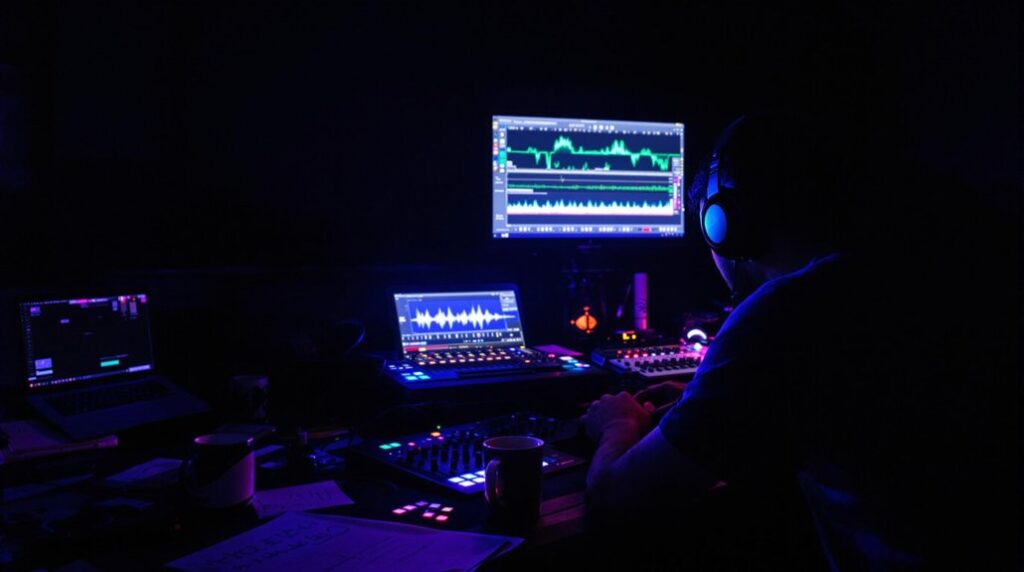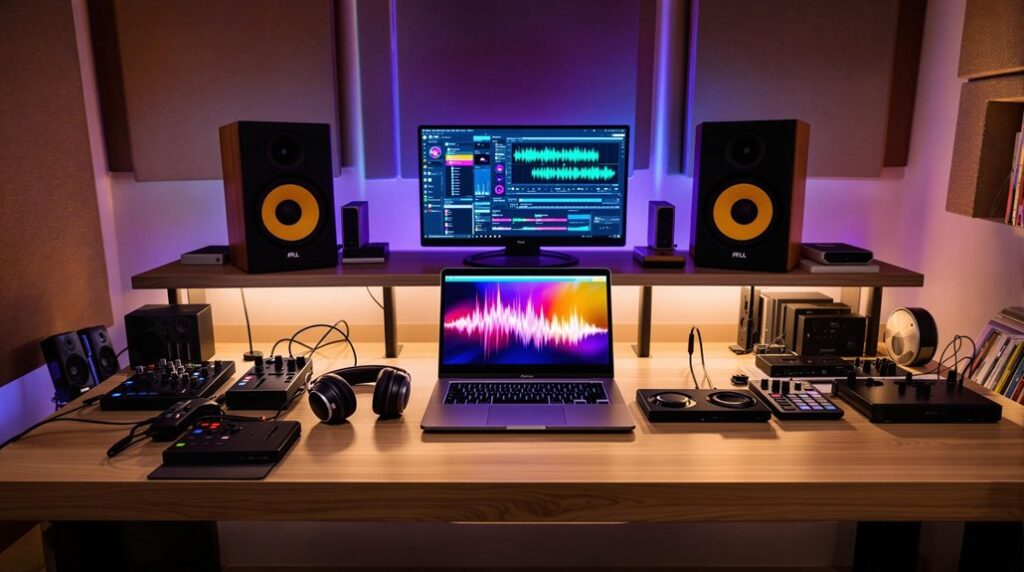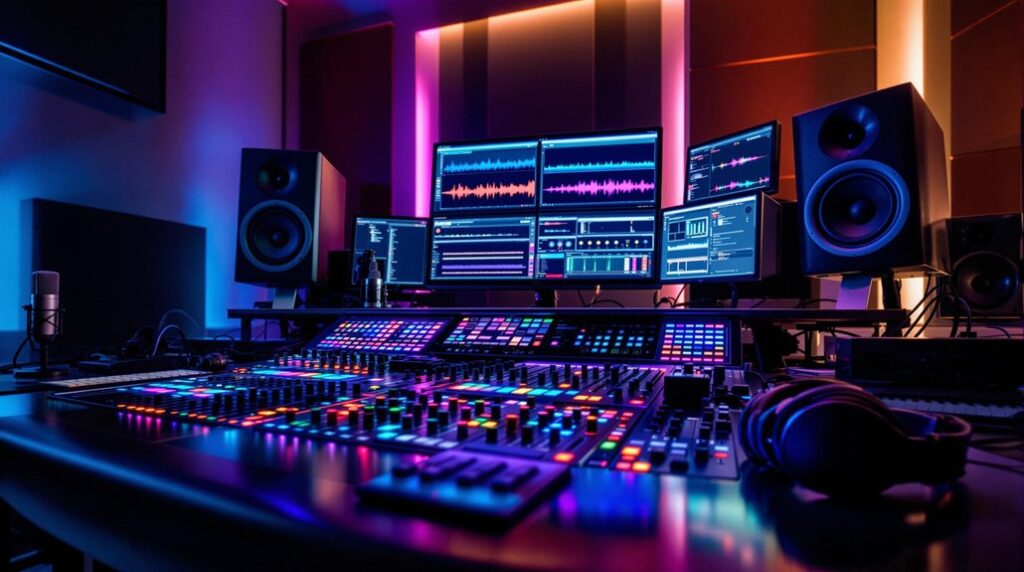To prepare your tracks for professional mixing, first, communicate your sonic goals clearly with reference tracks. Verify and match the file format, sample rate, and bit depth as per the engineer’s preferences. Guarantee all your tracks are well-edited, free of artifacts, and exported as continuous WAV files. Label and color-code your tracks consistently for easy navigation. Provide a rough mix and a reference track for genre comparison. Compress your files into a ZIP folder for integrity and ensure seamless file transfer. Share detailed session information to enable an efficient mix process. For a thorough understanding of these steps, keep going.
Key Takeaways
- Label tracks clearly and consistently, using the mix engineer’s preferred naming conventions.
- Provide continuous WAV files without gaps for seamless playback.
- Include a rough mix and a genre reference track to guide the mixing process.
- Confirm and match sample rate and bit depth for optimal audio quality.
- Compress files into a ZIP folder for transfer integrity and efficient delivery.
Communicate Your Expectations
Clearly articulating your expectations to the mixing engineer is essential for achieving the desired sound, vibe, and vision for your track. To start, you’ll want to clarify expectations by providing reference tracks that showcase the specific qualities you’re aiming for. These examples help the engineer understand your sonic goals more precisely.
Next, discuss any particular requirements or preferences you have for the mix. Whether it’s emphasizing certain instruments, adjusting vocal levels, or creating a specific atmosphere, clearly outline these details. This guarantees the engineer knows exactly what you want from the get-go.
It’s also vital to set boundaries regarding what’s and isn’t acceptable in the mix. For example, if you prefer not to have certain effects or processing techniques used, communicate these limitations upfront. This way, there are no surprises, and the mix stays true to your vision.
Establishing a clear line of communication is key. Regular check-ins and feedback loops allow you to stay involved in the process and make adjustments as needed. This ongoing dialogue ensures that your expectations are consistently met, resulting in a final mix that aligns perfectly with your artistic vision.
Verify Engineer Requirements
To guarantee a smooth mixing process, confirm the engineer’s preferred file format, such as WAV or AIFF, and adhere to their sample rate and bit depth requirements.
Label each track clearly and follow any specific naming conventions they provide.
Lastly, discuss the preferred method for delivering files, whether it’s through a cloud service or physical media.
File Format Specifications
Before you start exporting your tracks, confirm the mix engineer’s preferred file format, such as WAV or AIFF, to guarantee compatibility. Ensuring the correct file format is essential for maintaining audio quality and avoiding any issues during the mixing process. Engineers often have specific preferences that must be adhered to for quality assurance.
Next, check the sample rate specified by the engineer. Common sample rates include 44.1kHz and 48kHz. Matching the sample rate ensures that no quality is lost during conversion. Similarly, confirm the required bit depth—commonly 16-bit or 24-bit—to guarantee optimal audio resolution. Higher bit depths provide more dynamic range, which can be critical for professional mixing.
Additionally, verify whether the engineer prefers mono or stereo tracks. Exporting in the correct channel format can streamline the mixing process and meet the engineer’s workflow requirements.
Once all specifications are met, compress your files into a ZIP folder. This not only makes it easier to transfer the files but also maintains their integrity during sharing.
Track Labeling Guidelines
Once you have verified the file format specifications, make sure your tracks are labeled according to the mix engineer’s preferences for seamless integration into their workflow. Proper track labeling is essential for efficient mixing and avoiding unnecessary delays. Verify the mix engineer’s track labeling preferences, including naming conventions, numbering, and any specific information like instrument types.
Use clear and consistent labels. For instance, instead of generic names like “Track 1,” use detailed labels such as “01_Kick,” “02_Snare,” etc. Color coding can also enhance the organization by visually distinguishing different track groups. Implement track grouping to streamline the mix process; for example, group all drum tracks together, followed by bass, guitars, etc.
Below is a table with sample track labeling guidelines:
| Track Number | Track Name |
|---|---|
| 01 | 01_Kick |
| 02 | 02_Snare |
| 03 | 03_HiHat |
| 04 | 04_Bass |
| 05 | 05_RhythmGuitar |
Ensure each track is accurately numbered and listed to facilitate efficient navigation. By adhering to these guidelines, you’ll help the mix engineer achieve the best results. Remember, the more organized your tracks are, the smoother the mixing process will be.
Delivery Method Preferences
When preparing to deliver your tracks, make sure you’ve verified the mix engineer’s preferred file format, sample rate, and bit depth. Confirm whether they require dry, unprocessed tracks or tracks with specific effects applied. This guarantees that your files meet their technical requirements, facilitating a smoother mixing process.
Next, check if the engineer has specific guidelines for track organization, labeling, and file naming conventions. Properly labeled and organized files can greatly reduce setup time and potential errors. Discuss any tempo maps, markers, or session notes that might be needed. These elements are essential for maintaining the integrity of your project and ensuring an efficient workflow.
Understanding the engineer’s preferred method of file transfer is equally important. Whether they prefer cloud storage, email, or dedicated file-sharing platforms, make sure that the chosen method supports secure file sharing. Efficient transfer methods are crucial to prevent data loss and maintain the quality of your tracks.
Complete Editing and Tuning
Meticulously complete all pitch corrections, timing adjustments, and noise reductions to maintain the integrity and quality of your tracks before they reach the mixing stage. Start with vocal comping techniques to create the best possible performance by selecting the most compelling parts from multiple takes.
Use automation tips to smooth out volume inconsistencies and guarantee a consistent vocal delivery.
For drums, apply drum quantization to correct timing issues and lock in the groove, enhancing the rhythmic foundation of your track.
If your guitar parts lack the desired tone, consider guitar re-amping to achieve a more polished sound. Address any unwanted noises, such as clicks, pops, or hums, using noise reduction tools to ensure a clean final product.
Make sure all edits are seamless and properly crossfaded to avoid artifacts that can disrupt the mix. This process ensures that minor imperfections don’t become glaring issues after processing.
Your goal is to present tracks that are ready for professional mixing, where the engineer can focus on balance and sonic enhancement, rather than fixing basic issues. Proper editing and tuning are essential steps in achieving a professional-quality mix.
Organize and Label Tracks
Organizing and labeling your tracks with precision guarantees a streamlined workflow and makes it easier for both you and the mixing engineer to navigate the session efficiently.
Start by categorizing your tracks by instrument type, such as drums, guitars, and vocals. This kind of track arrangement ensures that similar elements are grouped together, facilitating quicker access and manipulation.
Use numbering or color-coding to assist with instrument identification in large sessions. Numbering can indicate track hierarchy, while color-coding visually separates different instrument groups, enhancing session organization.
Make sure that track names are clear and concise, accurately representing the instrument or part, such as ‘Kick Drum,’ ‘Lead Guitar,’ or ‘Backing Vocals.’ This eliminates guesswork and speeds up the workflow.
Organize your tracks in a logical order that mirrors the song structure, placing elements like the intro, verse, and chorus sequentially. This helps maintain an intuitive flow and makes it easier to follow the song’s progression.
Additionally, label tracks with essential details like BPM, key, and any specific processing or effects applied. This clear labeling provides the mixing engineer with vital information, ensuring a smooth and efficient mixing process.
Prepare Continuous WAV Files
To guarantee seamless playback during mixing, bounce continuous WAV files of each track without gaps or silence between sections. Start by trimming audio files precisely at the beginning and end to remove any unnecessary audio or empty space. This ensures a clean and consistent flow, preventing abrupt starts or stops that can disrupt the mixing process.
Check for any unwanted clicks, pops, or artifacts in your exported WAV files. These imperfections can negatively impact the mix, so use noise reduction tools to eliminate them. Ensuring high-quality tracks is essential for a professional result.
Next, verify that each continuous WAV file is properly labeled. Include track names, numbers, and any relevant details to facilitate easy identification and organization during mixing. This step helps the mixing engineer quickly locate and manage each track, saving valuable time and reducing the risk of errors.
Include a Rough Mix
Including a rough mix is essential as it provides a reference point for the mix engineer to grasp the desired vibe and arrangement of your song. This helps the engineer identify key elements like lead vocals, instruments, and effects, ensuring they’re prioritized correctly.
Establish Reference Point
A preliminary mix acts as an essential reference point, helping the mix engineer grasp the artist’s intended sound and ensuring the final product aligns with their creative vision. By providing a rough mix, you’re establishing rapport and creating a connection with the mix engineer, making it easier for them to understand the specific vibe, balance, and arrangement you envision for the track.
A rough mix can highlight important elements, effects, and sequences that should be retained or enhanced in the final mix. This reference allows the engineer to build upon your initial ideas, ensuring alignment with your creative direction. It also streamlines the workflow by offering a clear reference for tone, dynamics, and the overall feel of the track.
Here’s a quick comparison table to illustrate the benefits of including a rough mix:
| Aspect | Benefit |
|---|---|
| Vibe | Ensures intended atmosphere is captured |
| Balance | Maintains preferred levels of instruments |
| Arrangement | Keeps the structure and flow intact |
| Effects | Highlights specific effects to be retained |
| Workflow | Provides a clear starting point for the mix |
Communicate Musical Intent
Communicating your musical intent starts with providing a well-crafted rough mix that clearly conveys your vision to the mix engineer. This rough mix should showcase the desired vibe and sound, giving the mix engineer a solid foundation to build on.
Including reference tracks that highlight your sonic direction and feel will help in establishing trust and building rapport with the engineer.
Clearly communicate any specific preferences for instruments, vocals, effects, and overall balance. Your rough mix should highlight these elements, making it easy for the mix engineer to understand your artistic choices.
Share detailed notes on any key elements or moments in the song that require special attention during mixing. This could include specific sections where you want certain instruments to stand out or particular effects to be emphasized.
Collaborate closely with the mix engineer by discussing any specific artistic choices, arrangements, or mood requirements. This ensures that both of you’re on the same page, ultimately leading to a more cohesive and polished final mix.
Provide a Reference Track
Always guarantee you provide a reference track that exemplifies the sound, vibe, and style you aim for in your mix. This reference track should serve as a benchmark for genre comparison and production style, making sure your mix engineer understands the exact sonic direction you desire. By offering a track with similar instrumentation and production quality, you allow the engineer to align their mixing choices with your intended mood setting and overall sound.
A reference track acts as a guiding tool for balancing elements, managing dynamics, and applying effects. It showcases the levels of loudness, clarity, and spatial placement you expect in your mix. Ensure the reference track represents the overall sonic goal and feel of your song, bridging any potential gap in communication regarding your musical preferences.
When selecting a reference track, choose one within the same genre as your project. This helps the engineer make more accurate genre comparisons and decisions regarding the production style. The clearer the reference track, the better the engineer can recreate or enhance the desired sonic direction, leading to a cohesive final mix that aligns with your artistic vision.
Before sending your tracks for professional mixing, make sure you meticulously detail the session information to facilitate a smooth and efficient workflow for the mix engineer. Start by discussing session details such as the sample rate, bit depth, and tempo. These parameters are essential for maintaining audio quality and ensuring that the mix engineer can work seamlessly with your files.
Setting expectations is vital; communicate any special requirements or the desired vibe of the track. If you have reference tracks that capture the sound you’re aiming for, share them. This helps the engineer understand your artistic vision more precisely.
Include detailed notes on the song’s direction, instrumentation, and arrangement. Clearly outline the song structure, noting any tempo changes or key elements that could impact the mix. If you’ve used specific effects or plugins, provide this information as well, even if you expect the engineer to replace them with their own tools.
Collaborate by discussing track organization and labeling. Properly labeled tracks and organized sessions save time and avoid confusion. Mention any unique characteristics of the recording process that the mix engineer should be aware of, ensuring a cohesive and effective mixing experience.
Frequently Asked Questions
How to Make Your Mix Sound Professional?
To make your mix sound professional, optimize room acoustics to avoid unwanted reflections. Use reference tracks to match levels and tonal balance. Guarantee precise EQ, compression, and panning for clarity and separation in your mix.
How Do You Professionally Mix a Song?
To professionally mix a song, use advanced mixing tools like EQ, compression, and reverb. Always compare your mix to reference tracks to maintain a high standard. Adjust levels, panning, and effects meticulously for a polished sound.
How to Prepare Files for Mixing?
You should focus on file organization and use clear naming conventions. Consolidate files, label them properly as high-quality WAVs, include a rough mix and reference track, and communicate your processing preferences with the mix engineer.
How to Prepare Production for Mixing?
You’ll guarantee proper gain staging before sending your production for mixing. Organize your tracks meticulously, label everything clearly, and consolidate files. Double-check crossfades and fades, and communicate any specific requirements to the mix engineer.
Conclusion
By following these steps, you’ll guarantee your tracks are mix-ready.
Clearly communicate your expectations and verify any specific requirements your engineer has.
Complete all editing and tuning, organize and label your tracks meticulously, and prepare continuous WAV files.
Including a rough mix and a reference track will guide your engineer towards your desired sound.
Finally, share all essential session information.
These details will streamline the mixing process, guaranteeing a professional, polished final product.




